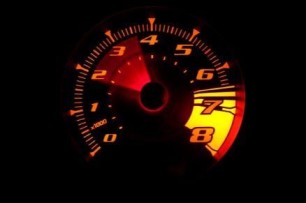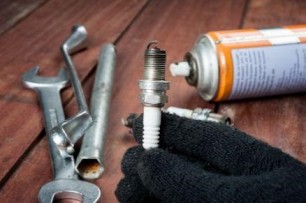General Insurance Blogs, Articles & Updates by - Magma HDI
Have us call you
- RENEW YOUR POLICY
- BUY NEW POLICY

Complete guide on rev matching on bikes
In India, the majority of motorcycles lack a slipper clutch. While learning motorcycle, many people find it challenging to downshift correctly. The engine comes under stress because they typically downshift while holding the clutch, which results in the higher gear accelerating harder than the lower gear at the same speed. To match that speed on the lower gear for a seamless transfer, one should preferably rev a bit higher before downshifting. Otherwise, you would be "engine-braking," which is not an intelligent way to slow down.
The correct way of downshifting is to blip the throttle between shifts to match the revs to the speed. This is also known as revving. In this post, we are talking all about it. So, without further due, let's get into it.
How to rev-match correctly?
● As you press the brakes, hold the clutch and downshift as you start to slow down (do not release the clutch yet).
● Now, "blip" the throttle while maintaining clutch pressure to increase engine RPM gently.
● As soon as the engine starts to rev, let go of the clutch instantly.
● Don’t forget to keep carefully applying the brakes. When you downshift, the aim is to match the revs needed for the bike to move at that precise pace.
● If your bike jerks and slows down unexpectedly, it means that the engine's RPM wasn't high enough. Try to rev it up further the next time you try it.
● The last step would be to practice and practice. Getting it right the first time is not necessary. Don't give up. You will learn how to downshift with time.
The importance of rev-matching.
Now that you know what occurs when your motorbike is rev-matched, let's talk about its significance. Downshifting without rev-matching may cause a significant shock in the motor while travelling at high speeds, especially on large bikes with high horsepower output. The result will be a back wheel that hops, skips, and steps out of alignment. In a scenario like this, controlling the motorcycle at high speeds requires excellent control and precision. The shock won't be as extreme or dramatic on motorcycles with less power, but it still has the potential to cause an accident.
Matching your RPM reduces engine wear and tear, yet another crucial justification for rev-matching. The shock that results from improper rev matching puts more strain on the engine and gearbox, among other parts.
Does rev matching consume more fuel?
The forceful use of the accelerator does cause it to use somewhat more fuel, but only little than usual.
If done properly, rev-matching can assist you in downshifting efficiently and reduce stress on your engine and clutch. It's a tactic that bikers employ frequently. It's crucial to keep in mind that you don't have to match your revs perfectly at first when you're practicing. To master, like with any other ability, rev-matching needs considerable practice. You will eventually be able to tell when your engine and road speed are in sync.
Take your first step towards rev-matching today, and don't forget to be safe. Riding on roads is always an invitation to mishaps that may be a potential threat to you and your bike. Always stay alert while riding, wear a protective gear helmet, and avoid overspeeding. Do not forget to invest in the best bike insurance for an additional safety net over your bike. Buy bike insurance online today and gift yourself with benefits that will eliminate the financial stress off you during panic situations.
Click HERE to buy bike insurance online and get rewarded with effective benefits.
Disclaimer: The information provided above is for illustrative purposes only. To get more details, please refer to policy wordings and prospectus before purchasing a policy.

Complete guide to changing the spark plug of your bike
If you are a biker, you know the importance of maintaining your bike in top-quality condition. Some people learn ways to keep their bikes on their own, while others depend heavily on mechanics and service stations to maintain their vehicles properly. In this article, we will understand the functions of one of the most vital components of a bike, the spark plug, and how to maintain and change it.
What is a spark plug?
A device that delivers electric current to the combustion system via the ignition point is known as a spark plug. A spark plug ignites and fuels the vehicle using an electric spark while maintaining the engine pressure.
What key dimensions do you need to look for in a spark plug?
1. Diameter:
The right diameter is imperative for the proper functioning of the spark plug. The wrong diameter can affect the internal components and damage the bike.
2. Reach:
The spark plug's optimal range or reach determines its ignition capacity. If the length of the spark plug is too short, it will fail the ignition. And if it is too long, it might ignite pre-emptively or get jammed and hit the valve inside.
3. Range:
The range of the spark plug is calculated by the distance from the insulator's tip to the ceiling ring. A longer distance will heat the plug and cause pre-ignition, while a shorter range results in a colder plug resulting in easy wear and tear.
4. Gap:
The distance between the centre and the grounded electrode is known as the spark plug gap. The bigger the size of the gap, the bigger the spark produced.
What are the indicators of a damaged spark plug?
1. When you stop the bike, and the engine starts sputtering or idling, it indicates a failed spark plug.
2. If you have trouble starting your bike engine, it could indicate trouble with ignition and the spark plug.
3. If you notice corrosion in various parts around the spark plug, then it is high time to change your spark plug.
4. You might have a faulty spark plug if you notice a poor fuel economy.
Various other factors are indicators of a faulty spark plug. If you notice any problem while riding your bike, it is best to take your vehicle to a mechanic and inspect it as soon as possible.
How to change a spark plug at home?
Although it is advisable to make any changes to your bike under the supervision of a trained mechanic, if you want to change your spark plug, the following list will help you with that.
1. The first thing that you need to do when changing a spark plug is to pull the cap and remove the wire. Remember to do it gently, as a sudden tug or pull can damage the connection and prevent the ignition from happening.
2. Attach the ratchet to the plug and make sure that the plug is fitting properly inside the socket. Using the ratchet, turn the spark plug till it is loose, and then carefully remove it.
3. Inspect the plug for oil and soot deposits or other damage. If the spark plug is greasy and dirty, it is high time to change it with a new one.
4. Before fixing a new spark plug, it is better to check for the range, diameter, and space of the spark plug. The exact spacing of the spark plug will be mentioned in the user manual.
5. Clean the new spark plug and place it neatly to ensure it fits properly.
6. Tighten the spark plug and put the cap back on.
These were the steps you need to follow when you want to change the spark plug of your bike. Remember that if you notice any abnormality with your bike and experience trouble while driving, it is best to get it checked by a mechanic. Invest in bike insurance to safeguard yourself against the cost of repair and maintenance. Bike insurance adds value to your bike and helps you gain a better riding experience with more focus on security and less financial stress.
Click HERE to buy bike insurance.
Disclaimer: The information provided above is for illustrative purposes only. To get more details, please refer to policy wordings and prospectus before purchasing a policy.

Learn about the best tips for ensuring the safety of maintenance workers
Maintenance workers are a highly underrated and neglected section of any organisation until a problem arises. Their day-to-day work requires many risky tasks as they have to come close to machinery or processes and repair them.
Such activities may include the disassembly and reassembly of complicated machinery. The chances of accidents are always high for them as maintenance activities are usually unplanned and involve the possibility of human error.
Let us learn about the best tips for ensuring the safety of maintenance workers.
1. Plan and stick to a schedule:
Maintenance activities should always be planned in advance so that workers get time to do a risk assessment and be mentally prepared for it. A regular safety check schedule should be put in place so that the maintenance workers know in advance the potential hazards of the task.
The tools and personal protective equipment (PPE) should be checked for safety on a routine basis. Proper planning and making a schedule for safety checks will also help the maintenance workers to sharpen their work skills according to the specific needs of the task.
2. Authorisation:
The proper authorisation should be in place for the operation of critical machinery. Only a few should have authorised access to critical work areas or permission to go near critical and complicated machinery. Power should be turned off when the machines are not working. The proper authorisation will ensure that no one turns on machinery or part of it while the maintenance workers are working on it.
3. Appropriate equipment:
The management should ensure that the maintenance workers have the appropriate equipment to perform their tasks. The workers should also consistently check on their equipment, whether a small drill machine or a welding machine. It should not happen that equipment fails to operate while performing a maintenance process and puts the worker and his team in danger.
The management must also ensure that they constantly upgrade and modernise the equipment to match the need of the hour and are not obsolete.
4. Working as a team:
Maintenance works are usually sudden and critical in nature. They come up when something important, such as the main production process, has stopped. The maintenance workers should work as a team because a lack of coordination in maintenance activity may lead to accidents and injuries.
The team should follow all the required safety processes and protocols. Also, they should do a thorough after-use check of all the critical equipment and tools they use. This will ensure the tools are fit for the next maintenance assignment.
5. Final checks and inspection:
The maintenance workers should thoroughly inspect the repair work they have performed. They should do a trial run of the machine only after they are fully satisfied with their work and are sure that everything is back in order. This will ensure their safety as otherwise, they may meet with an accident in case of incomplete repair work.
Maintenance workers are an essential part of an organisation's workforce. They put their lives at risk to fix the errors and bring back life to the stopped processes. While ensuring the safety of the maintenance workers, any company must also go for public liability insurance. It will protect the company if any third-party liability arises from accidents, injuries, or property damage.
Public liability insurance prices vary with a business's individual needs and the scale of its operations. One should compare the prices of policies available with different service providers and then make the purchase decision accordingly.
Click HERE to learn more about public liability insurance prices in India.
Disclaimer: The information provided above is for illustrative purposes only. To get more details, please refer to policy wordings and prospectus before purchasing a policy.

Know how you should ride your two-wheeler in the break-in period
Purchasing a vehicle is a big decision. It takes lots of planning, comparison of available options, and budgeting to arrive at the final pick. This applies to both cars and two-wheelers. Despite being significantly smaller and cheaper than their 4-wheeled counterparts, the extensive options in the market make it a tough choice for two-wheeler buyers. The ultimate decision depends on the budget and purpose of purchasing two-wheelers.
While it is mandated to buy two wheeler insurance India before hitting the road, once the paperwork is ready, all that’s left is for you to enjoy comfortable rides!
But there is one more piece of information you need to be aware of, i.e., Motorcycle Break-In. Does break-in sound unfamiliar, or are you wondering about its need? We’ve got all your questions covered below!
What is the breaking-in period?
The breaking-in period lasts for the initial 800 to 1600 kilometres for which the two-wheeler is driven. In simple words, it is the period it takes to get the new motorcycle running at its smoothest and allow the rider to get used to the vehicle.
Why is it necessary to break-in?
Breaking-in may seem like an unnecessary classification of a period that you can do away without any consideration. However, how the bike is operated initially impacts its running in the long run.
When a motorcycle is produced and advertised for sale, it goes through strict inspections and quality checks that guarantee the end user of its useability and safety. The main component of the bike, the engine, is fitted with several small parts that glide together smoothly to result in a perfect performance. This is facilitated by the ideal compression ratio, which is only possible if the engine fuel does not spread over the engine walls. Breaking-in correctly ensures that the piston, valve, cylinder walls, and piston rings generate friction such that a tight seal prevents the leak of fuel.
The benefits of proper breaking-in can be summarised as follows:
1. Lower carbon emissions
2. Optimised fuel usage
3. Longevity of engine life
The don’ts of two-wheeler break-in.
1. Don’t ignore the manufacturer’s instructions and take the word of other self-proclaimed experts.
2. Steer clear from rash driving under the false pretext that it would benefit your engine. It will only accelerate wear and tear and make the bike risky.
3. It is legally enforced to buy two wheeler insurance India immediately upon purchasing the vehicle before it is used. Ensure that you do not start the process without insurance.
The right way to ride your two-wheeler in the break-in period.
The proper technique of breaking-in subjects the engine to different stress levels such that the components adapt to each other and develop friction between themselves to create the perfect seal that prevents fuel spills. If the manufacturer has provided instructions, follow them to derive ideal results. In the absence of such instructions, follow the below-stated steps:
● Identify a comfortable stretch that allows shifting speeds and gears. Empty roads or highways are ideal
● Stick to the max speed of 50 Km/h and strictly ride without a pillion
● Use at most 3/4 throttle
● Alter gears with increasing speeds and do so gradually
● Ensure gradual breaks or acceleration instead of jolts
● Constantly monitor your bike’s engine speed and pay attention to your gear engagement to prevent motor lugging
● Allow your bike’s engine to cool down every 30 minutes while breaking-in to allow it to retain its shape
You can ensure a perfect break-in by keeping the above points in mind and following the instructions in your two-wheeler manual. Before you start the process, ensure that you buy two wheeler insurance India to protect your bike against any damages.
Click HERE to buy the best two wheeler insurance India.
Disclaimer: The information provided above is for illustrative purposes only. To get more details, please refer to policy wordings and prospectus before purchasing a policy.


